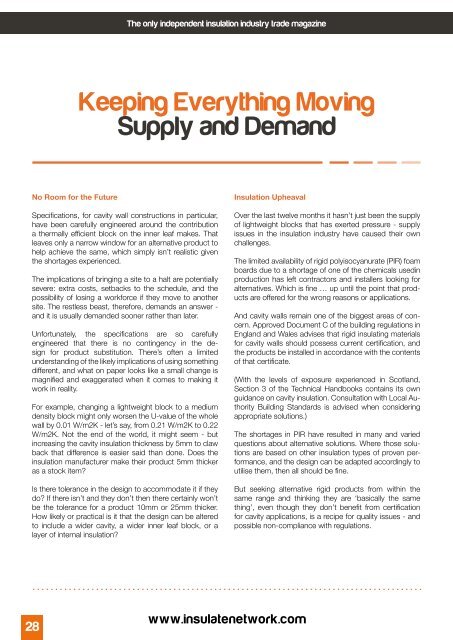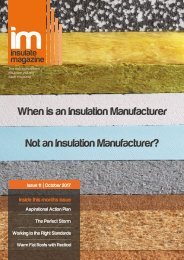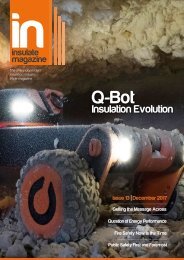Insulate Magazine Issue 14 - January 2018
Featuring exclusive articles, standing out from the crowd, NIA conference review, keeping everything moving and Review, Reflect and Reset the new year edition of insulation provides a kick start to 2018...
Featuring exclusive articles, standing out from the crowd, NIA conference review, keeping everything moving and Review, Reflect and Reset the new year edition of insulation provides a kick start to 2018...
Create successful ePaper yourself
Turn your PDF publications into a flip-book with our unique Google optimized e-Paper software.
The only independent insulation industry trade magazine<br />
Keeping Everything Moving<br />
Supply and Demand<br />
No Room for the Future<br />
Specifications, for cavity wall constructions in particular,<br />
have been carefully engineered around the contribution<br />
a thermally efficient block on the inner leaf makes. That<br />
leaves only a narrow window for an alternative product to<br />
help achieve the same, which simply isn’t realistic given<br />
the shortages experienced.<br />
The implications of bringing a site to a halt are potentially<br />
severe: extra costs, setbacks to the schedule, and the<br />
possibility of losing a workforce if they move to another<br />
site. The restless beast, therefore, demands an answer -<br />
and it is usually demanded sooner rather than later.<br />
Unfortunately, the specifications are so carefully<br />
engineered that there is no contingency in the design<br />
for product substitution. There’s often a limited<br />
understanding of the likely implications of using something<br />
different, and what on paper looks like a small change is<br />
magnified and exaggerated when it comes to making it<br />
work in reality.<br />
For example, changing a lightweight block to a medium<br />
density block might only worsen the U-value of the whole<br />
wall by 0.01 W/m2K - let’s say, from 0.21 W/m2K to 0.22<br />
W/m2K. Not the end of the world, it might seem - but<br />
increasing the cavity insulation thickness by 5mm to claw<br />
back that difference is easier said than done. Does the<br />
insulation manufacturer make their product 5mm thicker<br />
as a stock item?<br />
Is there tolerance in the design to accommodate it if they<br />
do? If there isn’t and they don’t then there certainly won’t<br />
be the tolerance for a product 10mm or 25mm thicker.<br />
How likely or practical is it that the design can be altered<br />
to include a wider cavity, a wider inner leaf block, or a<br />
layer of internal insulation?<br />
Insulation Upheaval<br />
Over the last twelve months it hasn’t just been the supply<br />
of lightweight blocks that has exerted pressure - supply<br />
issues in the insulation industry have caused their own<br />
challenges.<br />
The limited availability of rigid polyisocyanurate (PIR) foam<br />
boards due to a shortage of one of the chemicals usedin<br />
production has left contractors and installers looking for<br />
alternatives. Which is fine … up until the point that products<br />
are offered for the wrong reasons or applications.<br />
And cavity walls remain one of the biggest areas of concern.<br />
Approved Document C of the building regulations in<br />
England and Wales advises that rigid insulating materials<br />
for cavity walls should possess current certification, and<br />
the products be installed in accordance with the contents<br />
of that certificate.<br />
(With the levels of exposure experienced in Scotland,<br />
Section 3 of the Technical Handbooks contains its own<br />
guidance on cavity insulation. Consultation with Local Authority<br />
Building Standards is advised when considering<br />
appropriate solutions.)<br />
The shortages in PIR have resulted in many and varied<br />
questions about alternative solutions. Where those solutions<br />
are based on other insulation types of proven performance,<br />
and the design can be adapted accordingly to<br />
utilise them, then all should be fine.<br />
But seeking alternative rigid products from within the<br />
same range and thinking they are ‘basically the same<br />
thing’, even though they don’t benefit from certification<br />
for cavity applications, is a recipe for quality issues - and<br />
possible non-compliance with regulations.<br />
28<br />
www.insulatenetwork.com













